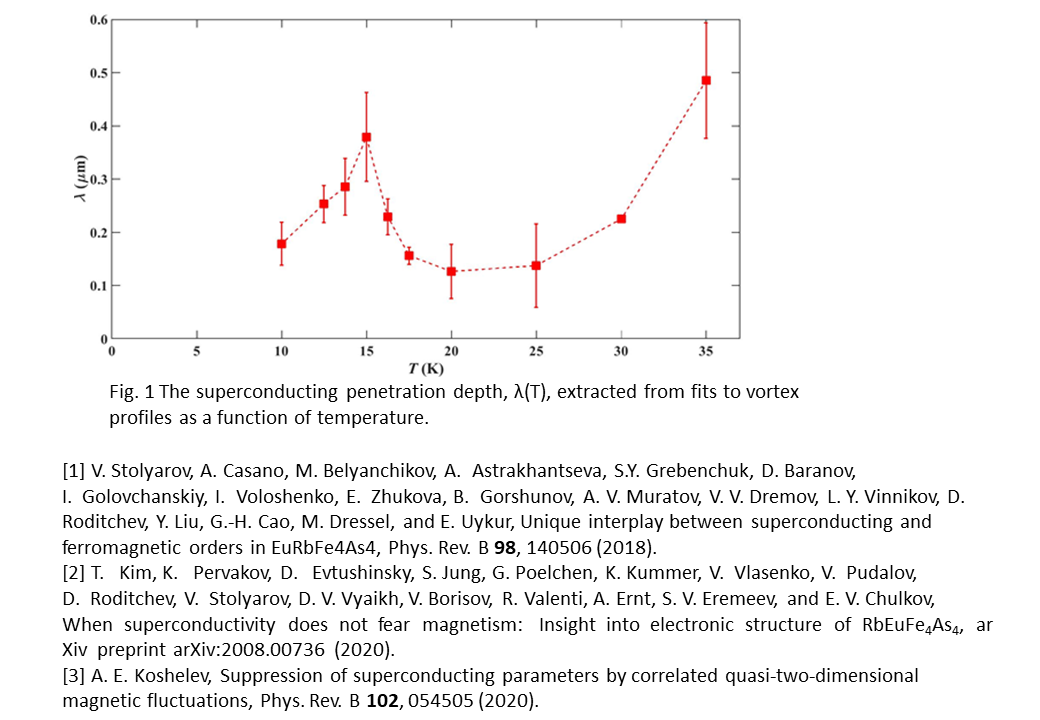PC9-2
Observing the Suppression of Superconductivity in the magnetic-Superconductor RbEuFe4As4 via Quantitative Magnetic Imaging
Dec.3 16:15-16:30 (Tokyo Time)
University of Bath, Claverton Down, Bath, BA2 7AY, United Kingdom1
Materials Science Division, Argonne National Laboratory, 9700, S. Cass Ave., Lemont, Illinois, 60439, USA2
Department of Physics and Astronomy, Hofstra University, Hempstead, New York, 115493, USA3
Department of Chemistry, Northwestern University, Illinois, 60208, USA4
The interplay between magnetism and superconductivity has fascinated scientists ever since the latter was discovered over 100 years ago, and the coexistence between these two ordered states has yet to be fully understood. Here we investigate the unusual interaction between the magnetic and superconducting sublattices in the magnetic iron-based superconductor, RbEuFe4As4, using quantitative magnetic imaging of superconducting vortices. Previous optical conductivity [1] and angle resolved photoemission spectroscopy [2] measurements on this material suggested a nearly complete isolation of the two sublattices. In contrast, our scanning Hall microscopy images of vortices reveal a substantial increase in the penetration depth near the magnetic ordering temperature, Tm, followed by a gradual reduction at lower temperatures (c.f., Fig. 1), indicating that the magnetic order leads to a significant reduction in the superfluid density. Our observations have been compared with a recently-developed model describing the suppression of superconductivity by correlated magnetic fluctuations [3]. Based on the qualitative agreement between the model and our data, we infer that the coupling between the Eu moments and Cooper pairs is weak enough that superconductivity is never destroyed, yet still strong enough to noticeably impact the superconducting parameters. Our results have important implications for understanding coexistence phenomena in other materials systems.
Fig. 1 The superconducting penetration depth, λ(T), extracted from fits to vortex profiles as a function of temperature.
[1] V. Stolyarov, A. Casano, M. Belyanchikov, A. Astrakhantseva, S.Y. Grebenchuk, D. Baranov, I. Golovchanskiy, I. Voloshenko, E. Zhukova, B. Gorshunov, A. V. Muratov, V. V. Dremov, L. Y. Vinnikov, D. Roditchev, Y. Liu, G.-H. Cao, M. Dressel, and E. Uykur, Unique interplay between superconducting and ferromagnetic orders in EuRbFe4As4, Phys. Rev. B 98, 140506 (2018).
[2] T. Kim, K. Pervakov, D. Evtushinsky, S. Jung, G. Poelchen, K. Kummer, V. Vlasenko, V. Pudalov, D. Roditchev, V. Stolyarov, D. V. Vyaikh, V. Borisov, R. Valenti, A. Ernt, S. V. Eremeev, and E. V. Chulkov, When superconductivity does not fear magnetism: Insight into electronic structure of RbEuFe4As4, arXiv preprint arXiv:2008.00736 (2020).
[3] A. E. Koshelev, Suppression of superconducting parameters by correlated quasi-two-dimensional magnetic fluctuations, Phys. Rev. B 102, 054505 (2020).
Keywords: Ferromagnetism, magnetic imaging, pnictide and hybrid
